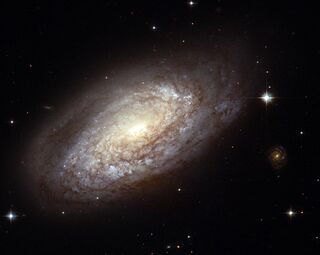Astronomy:NGC 2397
| NGC 2397 | |
|---|---|
 NGC 2397 by HST Credit: NASA, ESA & Stephen Smartt | |
| Observation data (J2000 epoch) | |
| Constellation | Volans |
| Right ascension | 07h 21m 19.89194s[1] |
| Declination | −69° 00′ 05.0140″[1] |
| Redshift | 0.004546[2] |
| Helio radial velocity | 1,357 km/s[3] |
| Distance | 69 Mly (21.18 Mpc)[3] |
| Group or cluster | NGC 2442[4] |
| Apparent magnitude (V) | 12.68[2] |
| Absolute magnitude (B) | −20.98[5] |
| Characteristics | |
| Type | SB(s)b[5] |
| Apparent size (V) | 1′.643 × 0′.887[6] |
| Other designations | |
| NGC 2397, PGC 20766 | |
NGC 2397 is a flocculent spiral galaxy[7] located in the southern Volans constellation, about one degree to the SSE of Delta Volantis.[8] English astronomer John Herschel discovered the galaxy on February 21, 1835.[9] It is located at a distance of approximately 69 million light years from the Sun,[3] and is a member of the small NGC 2442 group that includes NGC 2434.[4]
The morphological classification of NGC 2397 is SB(s)b,[5] which indicates this is a barred spiral (SB) with no ring structure around the nucleus (s) and moderately tightly–wound spiral arms (b). The nucleus is partly obscured[4] and consists of older yellow and red stars; more recent stars have formed within the outer blue spiral arms, which also feature protrusions of dust.[10]
In March 2006, a star in the galaxy, SN 2006bc, was spotted in the late stages of supernova.[11] Astronomers at Queen's University Belfast, who have been studying supernovas to find out what sort of stars explode, worked through previously captured images of the galaxy and found one of when the star exploded, one of only six ever collected.[12] Early spectra indicated this was a type II supernova, possibly of sub-type II-L or II-P.[13]
References
- ↑ 1.0 1.1 Brown, A. G. A. (August 2018). "Gaia Data Release 2: Summary of the contents and survey properties". Astronomy & Astrophysics 616: A1. doi:10.1051/0004-6361/201833051. Bibcode: 2018A&A...616A...1G. Gaia DR2 record for this source at VizieR.
- ↑ 2.0 2.1 "NASA/IPAC Extragalactic Database". Results for NGC 2397. http://nedwww.ipac.caltech.edu/cgi-bin/nph-objsearch?objname=NGC+2397#ObjNo1.
- ↑ 3.0 3.1 3.2 Tully, R. Brent et al. (2016). "Cosmicflows-3". The Astronomical Journal 152 (2): 21. doi:10.3847/0004-6256/152/2/50. 50. Bibcode: 2016AJ....152...50T.
- ↑ 4.0 4.1 4.2 Ryder, S. D. et al. (July 2001). "HIPASS Detection of an Intergalactic Gas Cloud in the NGC 2442 Group". The Astrophysical Journal 555 (1): 232–239. doi:10.1086/321453. Bibcode: 2001ApJ...555..232R.
- ↑ 5.0 5.1 5.2 Whitmore, Bradley C. et al. (April 2014). "The Luminosity Function of Star Clusters in 20 Star-forming Galaxies Based on Hubble Legacy Archive Photometry". The Astronomical Journal 147 (4): 18. doi:10.1088/0004-6256/147/4/78. 78. Bibcode: 2014AJ....147...78W.
- ↑ Skrutskie, Michael F.; Cutri, Roc M.; Stiening, Rae; Weinberg, Martin D.; Schneider, Stephen E.; Carpenter, John M.; Beichman, Charles A.; Capps, Richard W. et al. (1 February 2006). "The Two Micron All Sky Survey (2MASS)". The Astronomical Journal 131 (2): 1163–1183. doi:10.1086/498708. ISSN 0004-6256. Bibcode: 2006AJ....131.1163S.
- ↑ Carollo, C. M. et al. (December 1997). "Spiral Galaxies with WFPC2. I. Nuclear Morphology, Bulges, Star Clusters, and Surface Brightness Profiles". Astronomical Journal 114: 2366. doi:10.1086/118654. Bibcode: 1997AJ....114.2366C.
- ↑ Sinnott, Roger W.; Perryman, Michael A. C. (1997). Millennium Star Atlas. 1. Sky Publishing Corporation and the European Space Agency. p. 482. ISBN 0-933346-84-0.
- ↑ "NGC Objects: NGC 2350 - 2399". http://cseligman.com/text/atlas/ngc23a.htm#2397.
- ↑ "Exploding star in nearby galaxy". European Space Agency. 1 April 2008. http://www.esa.int/esaSC/SEMSPG5QGEF_index_0.html.
- ↑ "Exploding star in NGC 2397". Hubble. 31 March 2008. http://www.spacetelescope.org/news/heic0808/.
- ↑ O'Neill, Ian (April 5, 2008). "Supernova Precursor Discovered in Spiral Galaxy NGC 2397". Universe Today. http://www.universetoday.com/13500/supernova-precursor-discovered-in-spiral-galaxy-ngc-2397/.
- ↑ Szalai, T.; Vinkó, J. (January 2013). "Twelve type II-P supernovae seen with the eyes of Spitzer". Astronomy & Astrophysics 549: 14. doi:10.1051/0004-6361/201220015. A79. Bibcode: 2013A&A...549A..79S.
External links
 |

